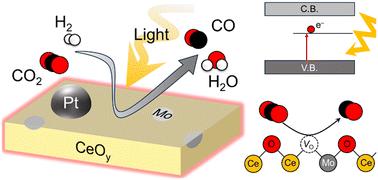mo修饰氧化铈†上逆水气转换的光诱导增强
IF 4.2
3区 化学
Q2 CHEMISTRY, PHYSICAL
引用次数: 0
摘要
将CO2转化为CO的逆水气转换反应(RWGS)是一种很有前途的可持续碳利用方法。然而,高能源需求对其实际应用构成了重大障碍。在这里,我们报道了铂负载金属修饰氧化铈催化剂(Pt/MxCe1−xOy)的开发,旨在通过光催化和光热催化方法提高RWGS反应效率,旨在利用太阳能。mo修饰催化剂在暗处473 K下的CO生成速率为10.2 mmol g−1 h−1,在可见光和近红外光照射下的CO生成速率为23.5 mmol g−1 h−1,其催化活性优于原始Pt/CeOy催化剂。详细表征表明,Mo掺杂提高了CO2的吸附和解离能力。此外,在可见光-近红外光照射下,由于光照射的热效应和非热效应,催化剂的性能进一步提高。这些发现强调了双重增强机制——光诱导的热和非热途径——显著提高了催化效率。这项研究为设计先进的光反应催化剂提供了有价值的见解,为高效和可持续的二氧化碳转化技术提供了一条有前途的途径。本文章由计算机程序翻译,如有差异,请以英文原文为准。

Photo-induced enhancement of reverse water–gas shift over Mo-modified cerium oxide†
The reverse water–gas shift (RWGS) reaction, converting CO2 into CO, is a promising approach for sustainable carbon utilization. However, high energy demand poses significant barriers to its practical application. Here, we report the development of platinum-loaded metal-modified cerium oxide catalysts (Pt/MxCe1−xOy), designed to enhance RWGS reaction efficiency through photocatalytic and photothermal catalytic approaches, aiming at solar light utilization. Mo-modified catalysts exhibited a high CO formation rate of 10.2 mmol g−1 h−1 at 473 K in the dark and 23.5 mmol g−1 h−1 under visible and near-infrared light irradiation, which outperformed the catalytic activity of the pristine Pt/CeOy catalyst. Detailed characterization revealed that Mo doping improved CO2 adsorption and dissociation capability. Moreover, under visible-NIR light irradiation, the catalyst performance further improved due to thermal and non-thermal effects of light irradiation. These findings highlight a dual enhancement mechanism—light-induced thermal and non-thermal pathways—that significantly boosts catalytic efficiency. This study provides valuable insights into designing advanced light-responsive catalysts, offering a promising pathway toward efficient and sustainable CO2 conversion technologies.
求助全文
通过发布文献求助,成功后即可免费获取论文全文。
去求助
来源期刊

Catalysis Science & Technology
CHEMISTRY, PHYSICAL-
CiteScore
8.70
自引率
6.00%
发文量
587
审稿时长
1.5 months
期刊介绍:
A multidisciplinary journal focusing on cutting edge research across all fundamental science and technological aspects of catalysis.
Editor-in-chief: Bert Weckhuysen
Impact factor: 5.0
Time to first decision (peer reviewed only): 31 days
 求助内容:
求助内容: 应助结果提醒方式:
应助结果提醒方式:


